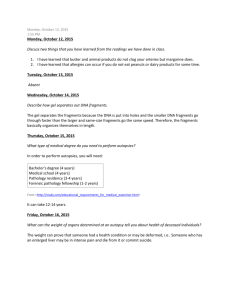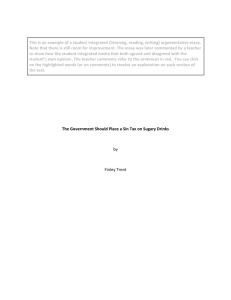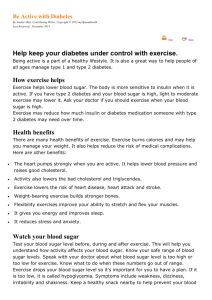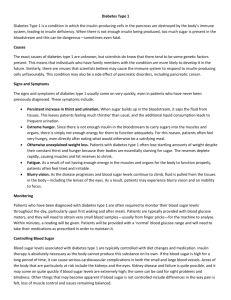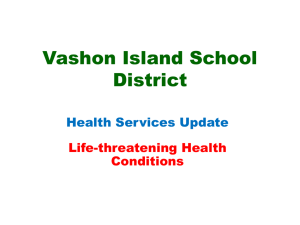Taking Control of Diabetes during Fasting
advertisement
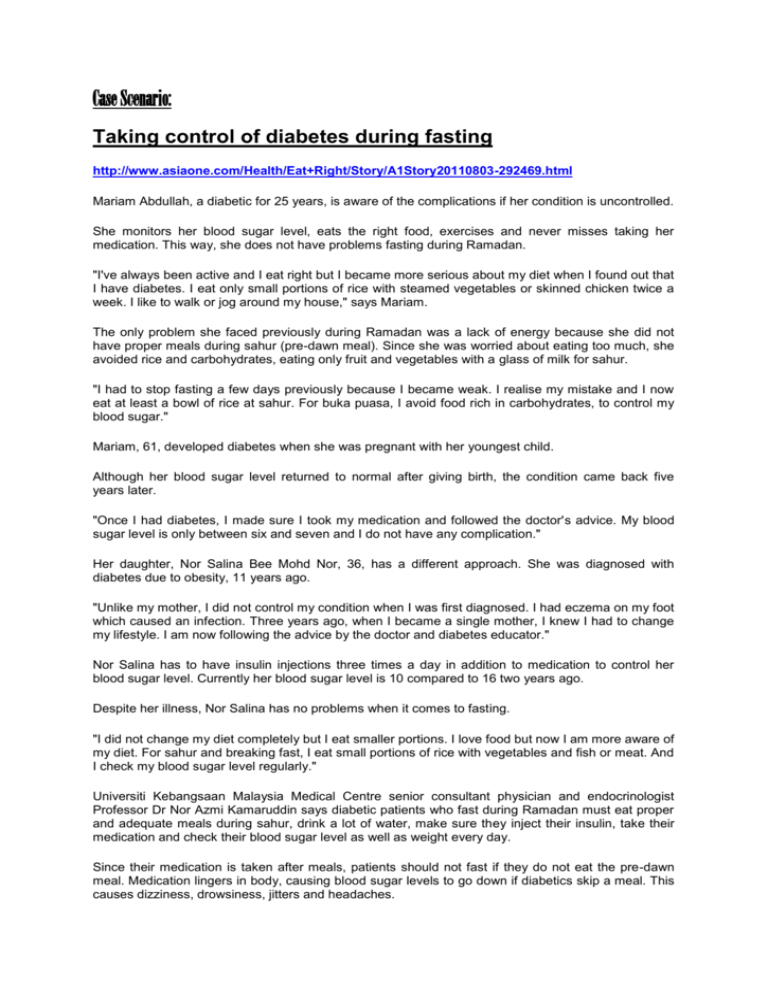
Case Scenario: Taking control of diabetes during fasting http://www.asiaone.com/Health/Eat+Right/Story/A1Story20110803-292469.html Mariam Abdullah, a diabetic for 25 years, is aware of the complications if her condition is uncontrolled. She monitors her blood sugar level, eats the right food, exercises and never misses taking her medication. This way, she does not have problems fasting during Ramadan. "I've always been active and I eat right but I became more serious about my diet when I found out that I have diabetes. I eat only small portions of rice with steamed vegetables or skinned chicken twice a week. I like to walk or jog around my house," says Mariam. The only problem she faced previously during Ramadan was a lack of energy because she did not have proper meals during sahur (pre-dawn meal). Since she was worried about eating too much, she avoided rice and carbohydrates, eating only fruit and vegetables with a glass of milk for sahur. "I had to stop fasting a few days previously because I became weak. I realise my mistake and I now eat at least a bowl of rice at sahur. For buka puasa, I avoid food rich in carbohydrates, to control my blood sugar." Mariam, 61, developed diabetes when she was pregnant with her youngest child. Although her blood sugar level returned to normal after giving birth, the condition came back five years later. "Once I had diabetes, I made sure I took my medication and followed the doctor's advice. My blood sugar level is only between six and seven and I do not have any complication." Her daughter, Nor Salina Bee Mohd Nor, 36, has a different approach. She was diagnosed with diabetes due to obesity, 11 years ago. "Unlike my mother, I did not control my condition when I was first diagnosed. I had eczema on my foot which caused an infection. Three years ago, when I became a single mother, I knew I had to change my lifestyle. I am now following the advice by the doctor and diabetes educator." Nor Salina has to have insulin injections three times a day in addition to medication to control her blood sugar level. Currently her blood sugar level is 10 compared to 16 two years ago. Despite her illness, Nor Salina has no problems when it comes to fasting. "I did not change my diet completely but I eat smaller portions. I love food but now I am more aware of my diet. For sahur and breaking fast, I eat small portions of rice with vegetables and fish or meat. And I check my blood sugar level regularly." Universiti Kebangsaan Malaysia Medical Centre senior consultant physician and endocrinologist Professor Dr Nor Azmi Kamaruddin says diabetic patients who fast during Ramadan must eat proper and adequate meals during sahur, drink a lot of water, make sure they inject their insulin, take their medication and check their blood sugar level as well as weight every day. Since their medication is taken after meals, patients should not fast if they do not eat the pre-dawn meal. Medication lingers in body, causing blood sugar levels to go down if diabetics skip a meal. This causes dizziness, drowsiness, jitters and headaches. "They think that if they do not eat during sahur, their blood sugar level will not go up. This is a misconception because the liver, which stores glucose, will immediately release it into the body if it detects low levels of insulin," says Dr Nor Azmi. During the fasting month, patients should check their blood sugar level before sahur and two hours after that, because there is a tendency for it to drop because of lack of food. A blood test should also be done two hours before breaking fast. According to research, patients develop hypoglycaemia (low blood sugar) within four to six hours after sahur and four to two hours before breaking fast. "They also need to drink a lot of water - at least three glasses - during sahur or they may get dehydrated. The sugar in their bodies will be excreted in the urine together with water. If they are dehydrated, they risk falling into a coma." Diabetics must check their weight every day during Ramadan. If they are losing weight too quickly, they should not be fasting. If they lose more than three per cent of their body weight a day, they will be in danger. Patients with poor control of their condition and the elderly who live alone should not fast. This includes diabetic children who have not reached puberty. Resources for module: 1. 2. 3. 4. 5. 6. 7. 8. Gap-minder World Mapper Health Promotion Board website Glogster/ My brochure maker online resources Youtube Animations on genetic engineering of insulin Cartoon guide to genetics H2 Biology Textbook by Campbell Activities or student investigations 1. Read the case study and do the analysis to define what they would like to report/ who the target audience is based on the article 2. Search for relevant information using the internet a. Visit Gapminder (no direct link to diabetes) thus obesity vs population, sugar vs age, BMI vs GDP, to make meaningful connections between risk factors and diabeters/ World mapper to look at Worldwide Diabetes prevalence Gapminder Image on BMI vs GDP Gapminder Image Daily sugar intake vs population Worldmapper Image on Prevalence of Diabetes b. Understanding the use and production of insulin as a method of management of diabetes http://www.abpischools.org.uk/res/coResourceImport/modules/hormones/enflash/geneticeng.cfm c. Any others (they may come up with things like WHO website etc) 3. Creating the poster/ brochure to create awareness Sample rubric Scientific Poster/ Brochure Rubric Poor Fair Good Excellent 0-1 2 3-4 5 Case Analysis 1-4 questions raised 1-4 questions raised 5 -7 questions More than 8 Sheet in each column. in each column. raised in each questions raised in Topic Hypothesis or Objective Research or Questions raised Questions raised are column. Questions each column. may not be relevant mostly relevant to raised are mostly Questions raised are to the topic. the topic. relevant to the all relevant to the topic. topic. Does not address Addresses the topic Related to the Defines a clear the research topic broadly but does research topic and objective that is not provide a provides a specific accurate and specific idea idea that may not related to the be accurate research topic Answers some Answers most Does not answer Answers some Score Review any questions suggested by the questions suggested questions and questions and by the hypothesis. includes a few other includes other interesting facts. interesting facts. hypothesis. Results Supporting data Supporting data Supporting data Supporting data and information are and information are and information are and information are missing and/ or both present with 2 both present and neatly compiled and inaccurate. or more minor accurate with one completely inaccuracies. mistake. accurate. Discussion & Presents an illogical Presents an illogical Presents a logical Presents a logical Conclusions explanation for explanation for explanation for explanation for findings - does not findings - barely findings -mostly findings which address hypothesis. supports hypothesis. support the support the hypothesis. hypothesis. Sources Only one to two ICT Only one to two ICT Four to five sources More than five sources used. No sources used. At (ICT and non-ICT credible sources non-ICT sources least one non-ICT based) used (ICT and non-ICT used. sources used. based) used Attractiveness Information Information Information Information & presented lacks presented shows presented shows presented shows Organization organization. some organization. good organization good and attractive Minimal use of Minimal use of with use of organization with graphics to support graphics to support appropriate use of appropriate the information. the information. headings. headings. Graphics Appropriate use of used are novel and graphics to support creative. the information. Overall Below Average Average Good Excellent Project Title:________________________________ _Evaluator Name: __________________________ Comments: Relevance to ‘O’ level and H2 Biology Links to ‘O’ level syllabus 1. 2. 3. 4. 5. Biological molecules (Nutrients, Enzymes) Nutrition (Diets, Organs like Pancreas, Diabetes) Homeostasis (Blood glucose control) Endocrine Control (Insulin and Glucagon) Molecular Genetics (Insulin Production) http://www.mysacredheartdiet.com/dietfor-diabetics/ http://www.umm.edu/patiented/articles/ what_type_1_diabetes_000009_1.htm Links to ‘A’ level syllabus 1. explain how the blood glucose concentration is regulated by insulin and glucagon. (Homeostasis). 2. outline the procedures involved in the production of insulin by genetic engineering technique. (Isolating, Cloning and Sequencing DNA) http://www.themedschoolproject.com/2 011/09/liberal-eugenics-medicine-or.html Linkshttp://bohone09.wikispaces.com/Group+7 to 21st Century Competencies 21st century skill competencies Relevance to the module 1. Students will gain awareness on global distribution of diabetes 2. Students will understand how diet and other Civic literacy, global awareness and crosscultural skills 3. 4. 1. 2. Critical and inventive thinking 3. 4. 5. 1. 2. Information and communication skills 3. By: Adrian Tan, Angela Ng, Marilyn Ng risk factors affect the chances of developing diabetes. Understand dietary restrictions across populations and religions Understanding world economy (countries that manufacture synthetic insulin for injections/ make use of biotechnology) Coming up with the case analysis and question that they want to address Students come up with hypothesis about the relationship between the various risk factors and diabetes Test the hypothesis by generating correlation using the data provided online eg. Gapminder Selection of appropriate data/information/graphics for presentation to their specified target audience Selection of appropriate student product Allows collaborative learning where students can develop their communication skills Students can learn to use different ICT tools (glogster, brochure maker, gapminder, world mapper etc) and internet search engines and relevant websites Reading the task aloud
